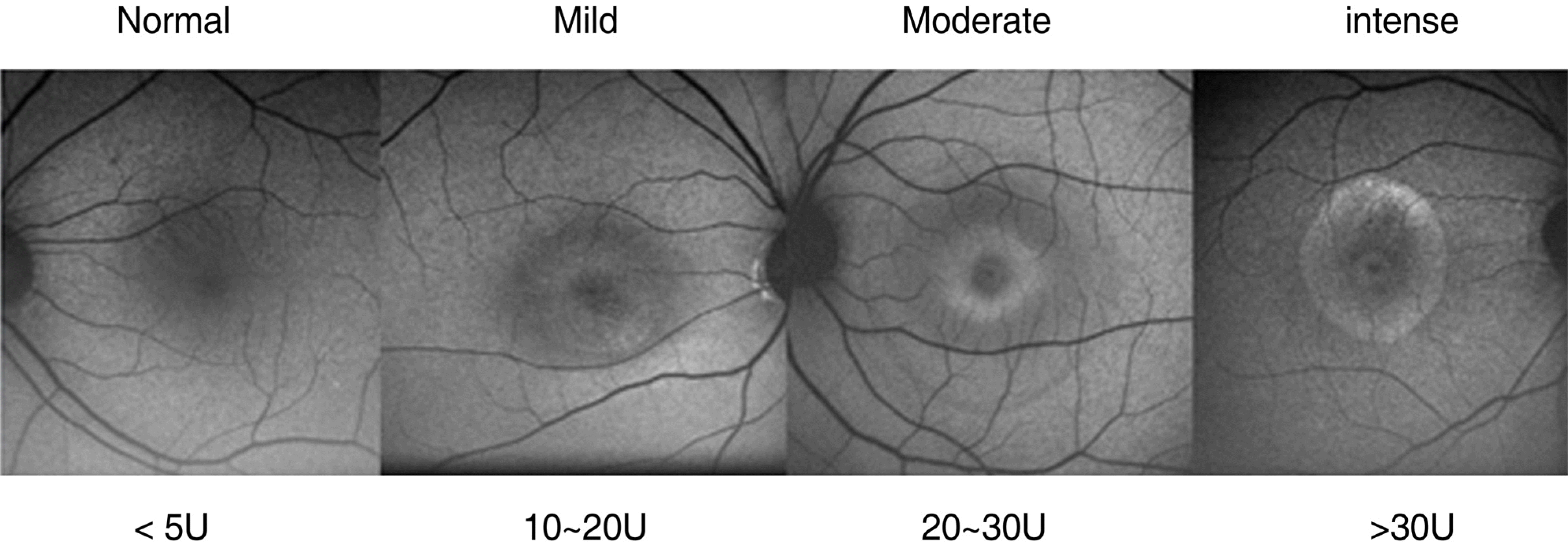Abstract
Purpose
The aim of this study was to evaluate the efficacy and potential value of fundus autofluorescence (FAF) in central serous chorioretinopathy (CSC).
Methods
FAF images were retrospectively evaluated in 122 eyes (119 patients) diagnosed with CSC by fluorescein angiography and OCT. Patients were classified into four groups (normal, mild, moderate, and intense) based on the intensity of FAF. We compared FAF patterns in acute and chronic-recurrent CSC and evaluated the differences in FAF according to the initial best corrected visual acuity (BCVA). We also assessed the differences in subretinal fluid resolution after laser photocoagulation among groups.
Results
In the chronic-recurrent group, a significant increase in FAF was observed compared to the acute group (p <0.001). The increase in initial visual acuity in the normal FAF group was statistically significant compared to the other groups (p <0.05). The difference in FAF between patients with acute and chronic-recurrent CSC was not significant. FAF imaging in CSC demonstrates different leakage patterns according to the course of the disease, but the changes in FAF did not correspond to the leakage patterns. In 51 eyes in the group without treatment and in 27 eyes of the focal treatment group, no significant difference was found in subretinal fluid resolution.
References
1. Spaide RF, Campeas L, Haas A. Central serous chorioretinopathy in younger and older adults. Ophthalmology. 1996; 103:2070–80.

2. Delori FC, Dorey CK, Staurenghi G. In vivo fluorescence of the ocular fundus exhibits retinal pigment epithelium lipofuscin characteristics. Invest Ophthalmol Vis Sci. 1995; 36:718–29.
3. von Rückmann A, Fitzke FW, Bird AC. Distribution of fundus autofluorescence with a scanning laser ophthalmoscope. Br J Ophthalmol. 1995; 79:407–12.
4. Eldred GE, Katz ML. Fluorophores of the human retinal pigment epithelium separation and spectral characterization. Exp Eye Res. 1988; 47:71–86.

5. Schmitz-Valckenberg S, Bültmann S, Dreyhaupt J, et al. Fundus autofluorescence and fundus perimetry in the junctional zone of geographic atrophy in patients with age-related macular degeneration. Invest Ophthalmol Vis Sci. 2004; 45:4470–6.

6. Framme C, Walter A, Gabler B, et al. Fundus autofluorescence in acute and chronic-recurrent central serous chorioretinopathy. Acta Ophthalmol Scand. 2005; 83:161–7.

7. Jorzik JJ, Bindewald A, Dithmar S, Holz FG. Digital simulta-neous fluorescein and indocyanine green angiography, auto fluorescence, and red-free imaging with a solid-state laser-based confocal scanning laser ophthalmoscope. Retina. 2005; 25:405–16.
8. Boulton M, McKechnie NM, Breda J, et al. The formation of autofluorescent grannules in cultured human RPE. Invest Ophthalmol Vis Sci. 1989; 30:82–9.
9. Holz FG, Schütt F, Kopitz J, et al. Inhibition of lysosomal degraditive functions in RPE cells by a retinoid of component of alipofuscin. Invest Ophthalmol Vis Sci. 1999; 40:737–43.
10. von Rückmann A, Schmidt KG, Fitzke FW, et al. Serous central chorioretinopathy; Acute autofluorescence of the pigment epithelium of the eye. Ophthalmology. 1999; 96:6–10.
11. von Rückmann A, Fitzke FW, Fan J, et al. Abnormalities of fundus autofluorescence in central serous retinopathy. Am J Ophthalmol. 2002; 133:780–6.

Table 1.
Patient demographics
Table 2.
Distribution of FAF characteristics in acute and chronic-recurrent CSC
| FAF change at the leakage point | Acute | Chronic-recurrent |
|---|---|---|
| Decreased at leakage point | 23 (51.2%) | 32 (50.8%) |
| Normal | 11 (24.4%) | 20 (31.8%) |
| Increased at leakage point | 11 (24.4%) | 11 (17.46%) |
Table 3.
Fundus autofluorescence and initial visual acuity
| Fundus autofluorescence group | Initial visual acuity (LogMAR) | p value∗(compared to normal group) |
|---|---|---|
| Normal | 0.21±0.21 | |
| Mild | 0.37±0.32 | 0.011 |
| Moderate | 0.44±0.39 | 0.017 |
| Intense | 0.42±0.33 | 0.015 |
Table 4.
Distribution of Fundus autofluorescence characteristics according to the different leakage pattern
Table 5.
The differences in subretinal fluid spontaneous resolution rate according to fundus autofluorescence group
Table 6.
The effect of focal laser photocoagulation in subretinal fluid resolution according to fundus autofluorescence group




 PDF
PDF ePub
ePub Citation
Citation Print
Print



 XML Download
XML Download